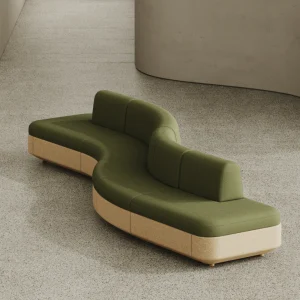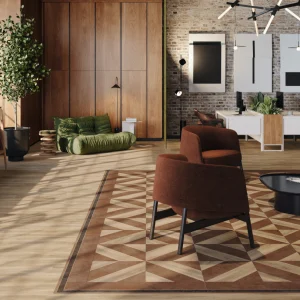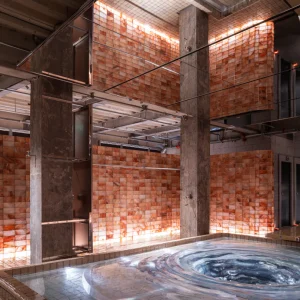
Lisbon’s second Architecture Triennale, which began on 14 October with three key exhibitions and runs until 16 January, is not Venice Lite. Its banner is Let’s Talk About Houses, but it is more than just an exploration of the house (safe as that would be). It goes back to the future with the Smithsons, shows off Peter Cook as a curator, showcases contemporary Portuguese architects and surveys architecture in art. Crucially, this Triennale is also rooted in Portugal’s very unique political and post-colonial experiences.
The main exhibition is at the Colecção Berardo Museum (situated in the monumental PoMo bunker of the Belem Cultural Centre), and is called Between North and South. Here, there are six sections in a maze of walls designed by MASS Atelier of Lisbon and punctuated by peep-through rectangles. There’s only one section of South, called Africa/Brazil: The Popular City, which exposes the rift between slums and condominiums. But there is plenty of North; indeed, the main action is almost extreme North. The Nordic Connection is curated by Sir Peter Cook of Archigram fame. Cook has been playful. While everything else is mounted in grey, his section is a passage of vibrant colour, and he has pretty well ignored the houses theme. Talking to the press, he said he’d considered the history of Scandinavian houses, but ‘I frankly got bored by that’. Instead, he’s selected eight practices and their works – projects ranging from children’s adventure camps by Helen & Hard to Dorte Mandrup’s iconic Herstedlund Community Centre. Tham & Videgård’s striking Malmø Art Museum fills a corner with bright red, although a section of cladding from the project itself is actually orange. A beautiful but bizarre installation of wood and cloth reaching high above the exhibition zone, by Mette Ramsgard Thomsen, is called ‘How would it be to live in a soft space…’ The answer must surely be to become a bat or a bird. Cook, bright and engaging with a manner not unlike Alec Guinness, told us: ‘There’s a delicacy in Nordic work which we don’t get in the Mediterranean’ – or, indeed, Portugal, which is on the Atlantic.

The British Council arranged the display of Peter and Alison Smithson’s House of Tomorrow, their futuristic 1956 design for living. Videos, furniture and the context of the show remind us how visionary this domestic utopia born out of austere times was. Simultaneously a defining moment in Modernism and now the essence of retro-cool, the The Smithsons’ vision predates The Jetsons by six years. Adjacent are photographs of the 1958 Patio and Pavilion project by Peter Smithson, Nigel Henderson and Eduardo Paolozzi. Behind this is a very different display. After the overthrow of Portugal’s totalitarian ‘New State’ dictatorship, architects under the acronym SAAL came out in 1974-76 to engage with a popular uprising that (amongst other things) demanded ‘Houses yes! Shacks no!’ Stencilled Rodchenko-style political posters adorn a cinema enclosure showing black-and-white film of the grassroots movement surging on the streets- banners, housewives and young men with tank tops and long hair. It’s fantastic footage, but there’s no information about SAAL, what it achieved (such as the projects in Porto by the giant of Portuguese architecture, Álvaro Siza), or why and how, perhaps uniquely, architects would and could have literally built themselves into a popular revolution. (The Triennale is, however, hosting a conference entitled [In] [Out] Politics on 19th and 20th November).
Like elsewhere, the best of Portuguese housing design is now market-driven. A section about recent Portuguese houses has the voices of affluent, satisfied occupants seeping from the walls of the section where their houses are displayed. The walk-through raised model of the Aires Mateus practice’s summer house in Azeitão seemed unlikely with its windowless box-like rooms cantilevered into and over a long interior, but photos of the real thing reveal it to be full of light and space.
Also in Belem, the brick-clad waterside Museu da Electricidade hosts the second exhibition. Breath-taking spaces in what was the Tejo Power Station (1914), framed by immaculately restored industrial pipes and machinery, are flooded with natural light. White Astroturf carpets a vast floor on which stands, petal-shaped to make scrutiny of models easier, show entries for two competitions, both related to the North/South question. A House in Luanda is precisely that, with a brief inspired by the 1958 Patio and Pavilion project to design a family unit costing no more than €25,000 for the Angolan capital. It’s rather like an update on Jean Prouvé’s Maison Tropicale, but for locals, and Siza himself headed the jury that sifted through 599 international entries. When curator João Luis Carrilho da Graça fielded questions from the floor, I asked: Isn’t this neo-colonialism? Wouldn’t nice, neat houses for all turn Luanda into LA? He did not seem to get it. The reality of Luanda is that it is an exploding urban dystopia of 5 million, poisoned by authoritarian politics and petrodollars, with the majority living in abject poverty without facilities. As someone brought up in Luanda later told me, you either steal electricity there or live from sunrise to sunset. She explained that multi-generational families and war widow mothers are the norm, making common domestic areas more important than private rooms. The metal mesh that defines courtyards in the winning entry by Pedro Reynolds de Sousa reminded her of prisons, or worse, zoo cages to show off animals.
Less controversial was the student competition to improve what is effectively Portugal’s very own favela, a Lisbon satellite settlement of immigrants called Cova da Moura. Manuel Aires Mateus curated this, and said ‘these areas have a lot to teach us’ and ‘we need to face these realities’. These are wise words- illegally-built shanty-towns may stink, but score well on density, community and sustainability. The designs here were about intervention, not replacement. The winning entry by Alexandre Vicente, Maria Macedo, Nuno Segura and Tuago Pereira is practical and positive, using red concrete lines and bench-walls to define public realm where there is vacant space.

The third great Triennale exhibition, When Art Speaks Architecture, runs until 21st November and is housed in the tight jumble of the old town at the Museu do Chiado, once a monastery but now the national contemporary art museum. The show spans the 60s and the present, and starts with Angela Ferreira’s Random Walk, a walk-through wooden installation revisiting the roof of Le Corbusier’s Villa Savoy. Curator Delfim Sado has picked many more contemporary works that engage Modernism, such as Fernanda Fragateiro’s untitled strip of boxes inspired by a housing project, or José Bechara’s deconstruction of cubes in Casa Amorosa. Outstanding is Fernando Brito’s shining Paradigmatic Building at a Scale of 1:25, a suspended mirror-surfaced model of Mies van der Rohe’s 1929 Barcelona Pavilion (plus a chair to contemplate it from). It seems to say: Behold the perfection of Modernism, pure geometric rationalism floating in conceptual Cartesian space! But why is this show obsessed with Modernism? What about addressing say Hi-Tech or parametric architecture, or challenging architecture’s spatial conceptions like Whiteread or Kapoor? The earnestness is broken by some laughs – Mark Dion’s Subterranean Museum (2005) exposes the wonders below in a cut through the plinth: pipes, an underground railway, even the bones of something big and pre-historic, possibly a dinosaur.

Big names from the 60s are enlisted to ‘speak architecture’. Hans Haacke’s Grosse Wasserwaage (1964), a water-filled metre-long tube hanging in the air, is an impossible water-level that could be saying to architecture: thinking big and staying on the level isn’t easy. There’s great photography… Next to one of Dan Graham’s glass and aluminium sculptures, Moon Windows (1989), are his photos of new 60s New Jersey housing. Like developments now, their style is based on safe traditional suburban houses, but Graham exposes their serial repetition, something shared with system-built block social housing. Next to them is Ed Ruscha’s Filthy McNasty series of photos (1966-69) of store-fronts and signage along Sunset Strip, with added vertical scratch lines. It is a perfect, scruffy counterpoint to the clean lines of Modernism.
The show’s fixation with Modernism makes for a consistent narrative, but perhaps a piece that’s not even in it talks deepest about the movement. A mural from Angela Ferreira’s A Scale connects the years 1850, 1875, 1925 and 1950, dates related to the museum’s collection. But it looks like a metro line map connecting stations in an ultra-Orwellian 1984 state where place names have been replaced with numbers. Rather like the de-localisation of architecture by Modernism.
Let’s Talk About Houses wants to promote architecture’s dialogue about and between North and South. Along with environmental sustainability (to which it is inextricably linked), issues don’t come bigger than that. It’s worth listening to Portugal about it, because its history as a global power beats anyone else’s by centuries. Addressing how to house third-world urban population growth, it may offer some dubious answers, but it sets an agenda. And let’s talk about the Triennale’s plus points. The presentation is excellent and the array of local and international talent strong and diverse. It’s a treat to review the Smithsons, enjoy the übercool splash of Scandinavian design, and see the Portuguese house as it moves on from Siza. Not least, Lisbon’s Triennale establishes itself with a strong identity, connecting the past and addressing the future not with parametric modelling or arty installations, but with global questions.





